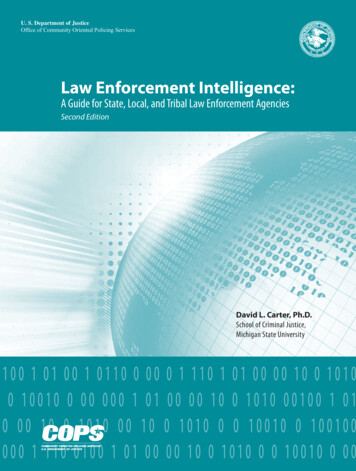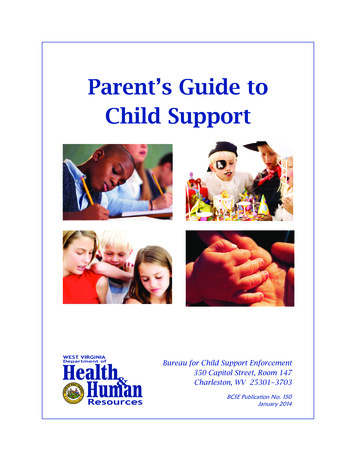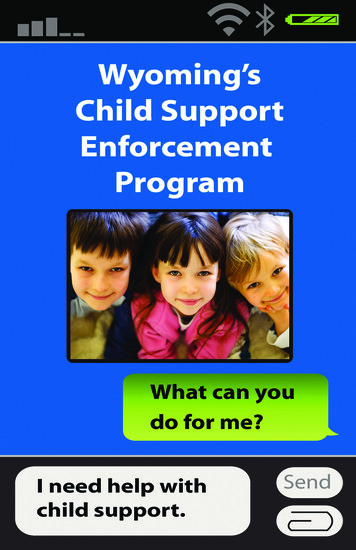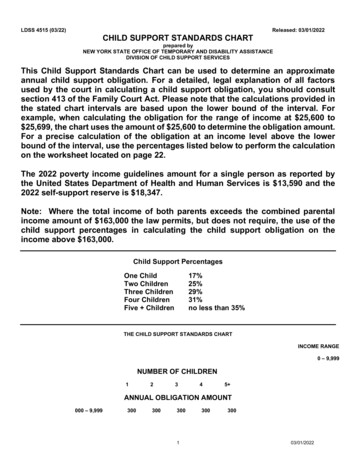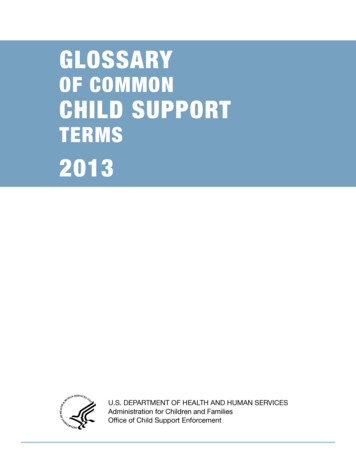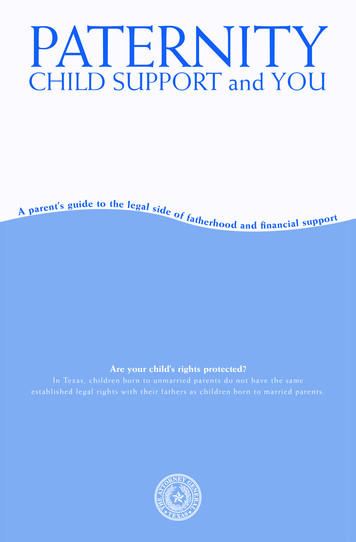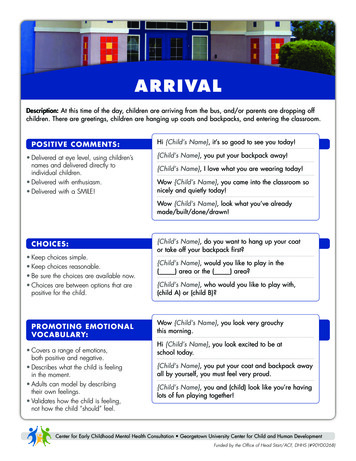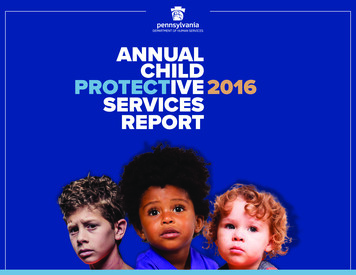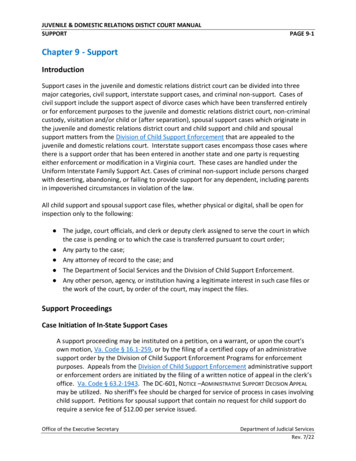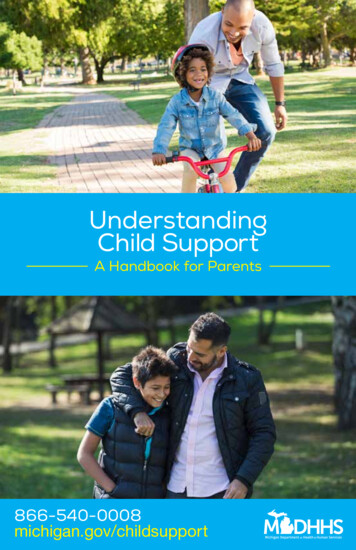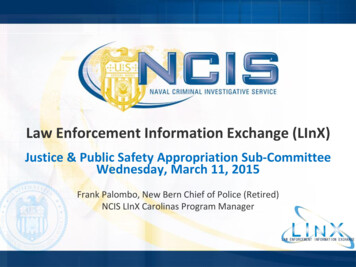
Transcription
.Child Support Enforcement: 25 Annual User FeeCarmen Solomon-FearsSpecialist in Social PolicyNovember 6, 2012Congressional Research Service7-5700www.crs.govRS22753CRS Report for CongressPrepared for Members and Committees of Congressc11173008
.Child Support Enforcement: 25 Annual User FeeSummaryP.L. 109-171, the Deficit Reduction Act of 2005, required states to impose a 25 annual user feefor Child Support Enforcement (CSE) services provided to families with no connection to thewelfare system. The user fee is to be assessed if the state CSE agency collects at least 500 inchild support payments on behalf of the family in a given fiscal year. The law gives the states fouroptions on how to obtain the user fee. According to an August 2012 survey of the 54 jurisdictionswith CSE programs, 18 jurisdictions pay the fee with state funds, 4 jurisdictions get the fee fromthe noncustodial parent, 1 jurisdiction imposes the user fee directly on the custodial parent, and31 jurisdictions impose the fee indirectly on the custodial parent by retaining the fee from thefamily’s child support payment (after 500 per year has been collected on behalf of the family).Congressional Research Service
.Child Support Enforcement: 25 Annual User FeeContentsBackground . 1Annual CSE User Fee . 2Implementation of CSE User Fee . 4TablesTable 1. Method By Which 25 CSE Annual User Fee Is Imposed . 4ContactsAuthor Contact Information. 6Congressional Research Service
.Child Support Enforcement: 25 Annual User FeeBackgroundThe Child Support Enforcement (CSE) program was enacted in 1975 as a federal-state program(Title IV-D of the Social Security Act) to help strengthen families by securing financial supportfor children from their noncustodial parent on a consistent and continuing basis and by helpingsome families to remain self-sufficient and off public assistance by providing the requisite CSEservices.The CSE program provides seven major services on behalf of children: (1) parent location, (2)paternity establishment, (3) establishment of child support orders, (4) review and modification ofchild support orders, (5) collection of child support payments, (6) distribution of child supportpayments, and (7) establishment and enforcement of medical child support. Collection methodsused by state CSE agencies include income withholding, intercept of federal and state income taxrefunds, intercept of unemployment compensation, liens against property, reporting child supportobligations to credit bureaus, intercept of lottery winnings, sending insurance settlementinformation to CSE agencies, authority to withhold or suspend driver’s licenses, professionallicenses, and recreational and sporting licenses of persons who owe past-due support, andauthority to seize assets of debtor parents held by public or private retirement funds and financialinstitutions.All 50 states, the District of Columbia, Guam, Puerto Rico, and the Virgin Islands operate CSEprograms and are entitled to federal matching funds. The federal government and the states shareCSE program costs at the rate of 66% and 34%, respectively. The CSE program serves bothwelfare and non-welfare families.1 Families receiving Temporary Assistance to Needy Families(TANF) assistance (Title IV-A), foster care payments (Title IV-E), Medicaid coverage (TitleXIX), or food stamp recipients who, at state option, are required by law to cooperate with theCSE agency, automatically qualify for CSE services free of charge. Other families must apply forCSE services, and states must charge an application fee that cannot exceed 25.21In FY2011, of the 15.8 million CSE cases, 13% (2.0 million) were in the TANF program, 43% (6.8 million) hadformerly been in the TANF program, and 44% (7.0 million) had never been in the TANF program.2The CSE program enacted in 1975 (P.L. 93-647) at first permitted, and then in 1984 (P.L. 98-378) required, the CSEagency to charge a one-time application fee for families not on welfare. In 1975, the law required that the applicationfee be reasonable, as determined by federal regulations. In 1984, the law specified that the fee could not exceed 25.The CSE agency may charge this fee to the applicant (i.e., the custodial parent) or the noncustodial parent, or pay thefee out of state funds. In addition, a state may at its option recover costs in excess of the application fee. Such recoveryof costs may be either from the custodial parent or the noncustodial parent. Although the application fee is mandatory,federal law allows the state to charge an amount that can range from 1 cent to 25. Many of the states that charge a 1or less application fee do so to maximize non-TANF clients’ access to CSE services. Many state CSE officials viewapplication fees as a barrier to clients who do not have the financial means to apply for services. They also claim thatfees and other charges may discourage clients from seeking services, because the fee is paid regardless of whether anychild support is collected on behalf of the family. Others view application fees for non-TANF families as a way toreduce CSE program costs. The legislative history of P.L. 98-378 (S. Rept. 98-387, p. 30-31; April 9, 1984) says: “TheCommittee believes that this minimal fee requirement represents a reasonable way to help defray some of the costsincurred in processing the application and in providing support enforcement services. This fee would still besignificantly less costly to the non-AFDC applicant than the cost of pursuing support enforcement through a privateattorney.”Congressional Research Service1
.Child Support Enforcement: 25 Annual User FeeAnnual CSE User FeeP.L. 109-171 (Section 7310), the Deficit Reduction Act of 2005 (enacted February 8, 2006),required families that have never been on the TANF program to pay a 25 annual user fee whenthe Child Support Enforcement (CSE) program collects at least 500 in child support annually(from the noncustodial parent) on their behalf.3P.L. 109-171 provides the state with four options on how to collect the fee. The 25 user fee maybe (1) retained by the state from child support collected on behalf of the family (but the 25cannot be part of the first 500 collected in any given federal fiscal year); (2) paid by thecustodial parent; (3) recovered/recouped from the noncustodial parent; or (4) paid by the state outof state funds.4The intent of the 25 user fee is to recoup in part the costs of the CSE program to the federal andstate governments by decreasing CSE program expenditures.5 The 25 user fee (from custodialand noncustodial parents) is considered income to the CSE program. The federal and stategovernments share income to the CSE program (sometimes referred to as cost recovery) at thesame rate that they share program costs (i.e., 66% federal and 34% state). The CongressionalBudget Office (CBO) estimated that the 25 CSE annual user fee provision would save thefederal government 405 million and the state governments 215 million over the nine-yearperiod FY2007-FY2015.6After the 25 user fee was enacted, there was a lot of interest in how it would be implemented.Most of the arguments about the user fee (for and against) concerned the option that permittedstates to charge the custodial parent.Persons in favor of the mandatory 25 annual user fee maintain that it will, to a limited extent,compensate the federal government and the states for operating a CSE program. They claim thateven on top of the CSE application fee, the CSE program is still a bargain for custodial parents.They argue that there is no comparison between the nominal fees that the CSE program chargesand the much higher fees that a private attorney or collection agency would charge for obtainingchild support payments. They say that unlike the CSE application fee, it only applies to those whohave received a certain amount of child support payments. They also point out that 72% ofcustodial parents had income above the poverty level (2009 Census data)7 and thereby could3Provision of a mandatory 25 annual user fee for non-welfare CSE families has been discussed for many years. Sucha proposal was included in the George H. W. Bush Administration’s FY1992 budget proposals and in the George W.Bush Administration’s FY2003 budget proposals. For additional information, see States’ Practices and Perspectivesfor Assessing Fees for Child Support Services to Applicants not Receiving Aid to Families with Dependent Children,U.S. Department of Health and Human Services, Office of Inspector General, July 8, 1992 f. Also see Feasibility of Collecting Fees for Child Support Services, by Carol Welch,Washington State, Department of Social and Health Services, Division of Child Support, Fiscal Management, June2001, dy.pdf.4If the 25 annual user fee is paid by the state out of state funds, it is not considered an administrative cost of the CSEprogram and thus is not eligible for 66% federal matching funds.5In FY2011, CSE program expenditures amounted to nearly 5.7 billion; child support payments collected fromnoncustodial parents by CSE agencies totaled 27.3 billion.6Congressional Budget Office, Cost Estimate of S. 1932 (Deficit Reduction Act of 2005), January 27, 2006, p. 55 and p.60.7U.S. Census Bureau, Custodial Mothers and Fathers and Their Child Support: 2009, by Timothy S. Grall, P60-240,(continued.)Congressional Research Service2
.Child Support Enforcement: 25 Annual User Feeprobably afford to pay the user fee without it negatively affecting their standard of living. Inaddition, they assert that it is normal practice to charge a fee or user charge for services rendered.Persons opposed to the mandatory 25 annual user fee (that is imposed on the custodial parent)contend that it treats similarly situated families in an unequal manner. They argue that a lowincome custodial parent who has not had to go on welfare needs child support just as much as acustodial parent who formerly was on welfare (i.e., the TANF program). They contend that the 25 annual fee would impose a new surcharge on working poor families who were previouslysuccessful in remaining self-sufficient. They contend that fees generally take away funds thatotherwise could be available to the child and the family. They also point out that because the 25user fee is considered CSE program income, the state gets 34% of the 25 fee ( 8.50) and thefederal government gets the remaining 66% ( 16.50). They claim that the administrative cost ofreprogramming a state’s automated computer system to account for the fee would outweigh thefinancial benefit of the fee’s increased income to the state. They also say that the financial benefit,if any, to the federal government would be negligible.8According to the Lewin Group/ECONorthwest report entitled Anticipated Effects of the DeficitReduction Act Provisions on Child Support Program Financing and Performance Summary ofData Analysis and IV-D Director Calls (July 20, 2007):Many directors noted potential benefits of the fee, including program revenue and instilling asense of ownership in one’s child support case. Directors, though, identified more drawbacksto the fee. All directors expected the cost of programming the statewide automated systemwould exceed the revenue generated from the fee, at least in the short-term. This occurs at atime when they are already facing budget cuts or foregoing other project enhancements.Some expressed concern that it will take money from low-income families; others fear it willdrive customers—largely consistent payers—from the program, hurting not only childsupport program performance but families as well. One-fourth of the surveyed directorsstated that their programs would not charge the fee and would pay the federal share out ofprogram resources.9The final regulation pertaining to the 25 CSE annual user fee includes the following commentfrom OCSE:The Federal Government continues to pay 66 percent of State costs to operate child supportenforcement programs. This is a generous matching rate, exceeding the administrativematching rate of other programs such as Medicaid and Food Stamps. Therefore, we do notbelieve that the annual fee amounts to direct compliance costs on States and localgovernments, nor does it have a federalism impact.10(.continued)December 2011, p. 6.8National Child Support Enforcement Association (NCSEA), Resolution on 25 Annual Fee, June 17, 2002, .pdf.9See http://www.nccsd.net/documents/nccsd final report revised 2 437782.pdf.10Federal Register, vol. 73, no. 237, U.S. Department of Health and Human Services, Office of Child SupportEnforcement, Final Rules, December 9, 2008, pp. 74913-74914 -28660.pdf#page 1).Congressional Research Service3
.Child Support Enforcement: 25 Annual User FeeAccording to a Government Accountability Office (GAO) report:Some CSE officials we interviewed stated that their states absorbed the 25 service fee dueto concerns that the fee would be a burden, while others said that they charged the fee tocustodial parents because their states couldn’t afford to absorb the fee due to budgetaryconstraints. Some of the latter told us that the reason they charged the service fee tocustodial, rather than noncustodial, parents was because it was easier administratively. A fewalso reported that families affected by the fee had voiced little opposition to it.11Implementation of CSE User FeeThe provision mandating a 25 annual user fee became effective on October 1, 2006. However,some states had to enact the provision into state law before they could impose the mandatory 25user fee. The proposed regulations on the user fee were published in January 2007.12 The finalregulations were published on December 9, 2008, and became effective on February 9, 2009.13Table 1 is based on a survey of the states by the National Council of Child Support Directors andinformation from state CSE agencies. Table 1 indicates that of the 54 jurisdictions with CSEprograms, 18 jurisdictions pay the fee with state funds, 4 jurisdictions get the fee from thenoncustodial parent, 1 jurisdiction imposes the user fee directly on the custodial parent, and 31jurisdictions impose the fee indirectly on the custodial parent by retaining the fee from thefamily’s child support payment (after 500 per year has been collected on behalf of the family).Table 1. Method By Which 25 CSE Annual User Fee Is ImposedStateFee Paid byState Out ofState FundsFee Paid byNoncustodialParentFee Paid byCustodialParentAlabamaAlaskaFee Paid Out ofChild doXConnecticutXDelawareXDistrict of ColumbiaXFloridaX11U.S. Government Accountability Office, Child Support Enforcement: Departures from Long-term Trends in Sourcesof Collections and Caseloads Reflect Recent Economic Conditions, GAO-11-196, January 2011, p. 24.12Federal Register, vol. 72, no. 15, January 24, 2007, Child Support Enforcement Program, pp. 3093-3102. Theproposed regulations can be found at t-07-01.htm.13Federal Register, vol. 73, no. 237, Department of Health and Human Services, Office of Child Support Enforcement,Final Rules, December 9, 2008, pp. 2-09/pdf/E828660.pdf#page 1).Congressional Research Service4
.Child Support Enforcement: 25 Annual User FeeStateFee Paid byState Out ofState FundsFee Paid byNoncustodialParentGeorgiaGuamFee Paid byCustodialParentFee Paid Out ofChild tanaXNebraskaXNevadaXNew HampshireXNew JerseyXNew MexicoXNew YorkXNorth CarolinaXNorth DakotaXOhioXOklahomaXOregonXPennsylvaniabXPuerto RicoXRhode IslandXSouth CarolinaSouth DakotaXXTennesseeXTexasXCongressional Research Service5
.Child Support Enforcement: 25 Annual User FeeStateFee Paid byState Out ofState FundsUtahVermontFee Paid byNoncustodialParentFee Paid byCustodialParentFee Paid Out ofChild SupportPaymentXXVirgin IslandsXVirginiaXWashingtonXWest VirginiaXWisconsinXWyomingXSource: Table prepared by the Congressional Research Service on October 11, 2012, based on data from theOffice of Child Support Enforcement website (Intergovernmental Reference Guide tml). The website was last modified on August 10, 2012.a.Maryland pays the 25 CSE annual user fee out of state funds for cases in which the annual child supportcollection is between 500 and 3,499.99. If the annual child support collection is 3,500 or more, the 25annual CSE user fee is retained from child support payments.b.Pennsylvania pays the 25 CSE annual user fee out of state funds for cases in which the annual child supportcollection is between 500 and 1,999.99. If the annual child support collection is 2,000 or more, the 25annual CSE user fee is retained from child support payments.Author Contact InformationCarmen Solomon-FearsSpecialist in Social Policycsolomonfears@crs.loc.gov, 7-7306Congressional Research Service6
the Child Support Enforcement (CSE) program collects at least 500 in child support annually (from the noncustodial parent) on their behalf.3 P.L. 109-171 provides the state with four options on how to collect the fee. The 25 user fee may be (1) retained by the state from child support collected on behalf of the family (but the 25
